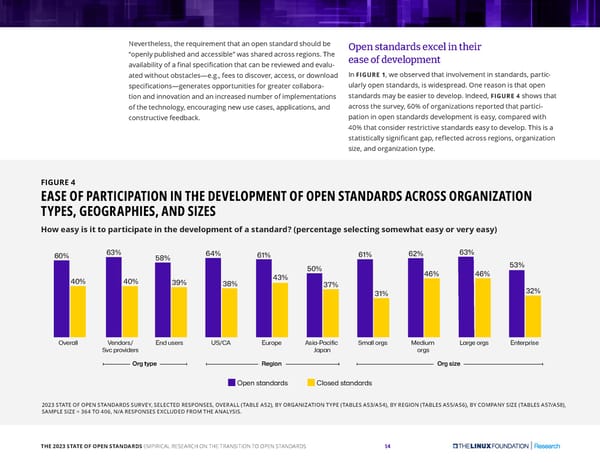Nevertheless, the requirement that an open standard should be Open standards excel in their “openly published and accessible” was shared across regions. The ease of development availability of a final specification that can be reviewed and evalu- ated without obstacles—e.g., fees to discover, access, or download In FIGURE 1, we observed that involvement in standards, partic- specifications—generates opportunities for greater collabora- ularly open standards, is widespread. One reason is that open FIGURE 4 shows that tion and innovation and an increased number of implementations standards may be easier to develop. Indeed, of the technology, encouraging new use cases, applications, and across the survey, 60% of organizations reported that partici- constructive feedback. pation in open standards development is easy, compared with 40% that consider restrictive standards easy to develop. This is a statistically significant gap, reflected across regions, organization size, and organization type. FIGURE 4 EASE OF PARTICIPATION IN THE DEVELOPMENT OF OPEN STANDARDS ACROSS ORGANIZATION TYPES, GEOGRAPHIES, AND SIZES How easy is it to participate in the development of a standard? (percentage selecting somewhat easy or very easy) 60% 63% 58% 64% 61% 61% 62% 63% 50% 53% 43% 46% 46% 40% 40% 39% 38% 37% 31% 32% Ov�rall V�ndor�/ End u��r� US/CA Europ� A�ia-Paci�ic Small org� ��dium Larg� org� Ent�rpri�� Svc provid�r� Japan org� Org typ� R�gion Org �iz� Op�n �tandard� Clo��d �tandard� 2023 STATE OF OPEN STANDARDS SURVEY, SELECTED RESPONSES, OVERALL (TABLE A52), BY ORGANIZATION TYPE (TABLES A53/A54), BY REGION (TABLES A55/A56), BY COMPANY SIZE (TABLES A57/A58), SAMPLE SIZE = 364 TO 406, N/A RESPONSES EXCLUDED FROM THE ANALYSIS. THE 2023 STATE OF OPEN STANDARDS EMPIRICAL RESEARCH ON THE TRANSITION TO OPEN STANDARDS 14
 The 2023 State of Open Standards Page 13 Page 15
The 2023 State of Open Standards Page 13 Page 15